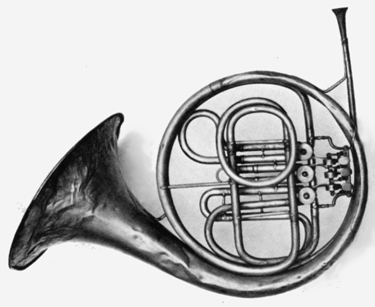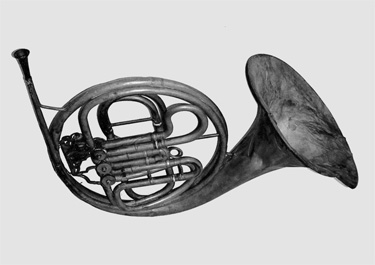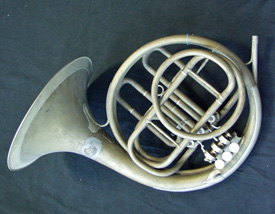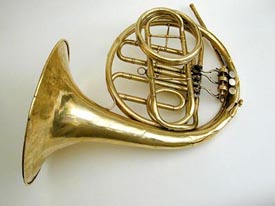| . (click on photos for larger view) |
|
 |
 Horn by F.A. Schmidt, ca 1850 Photos courtesy of Musikinstrumenten-Museum, Leipzig |
The term Kölner (Cologne) model horn was coined by Friedrich Adolf Schmidt sometime after 1850. The Kölner design has six sections in the following order: (1) conical leadpipe, (2) valves, (3) cylindrical intermediate piece, (4) tuning slide, (5) conical first branch, (6) bell tail and bell. The cylindrical portion is about one quarter to one third of the total horn length with the valves are located at one third or slightly less of the total length. This allows for a much longer slow-tapered leadpipe. It is a modification of the model developed by C.A. Mueller in Mainz sometime after 1827. In Cologne F.A. Schmidt built a modified high quality version of Mueller's design from about 1850. By the end of the 19th century and into the first decades of the twentieth century it was known as the Kölner model. It was often copied by other makers and adapted to local traditions (see other examples, listed below). Until 1890 it was fitted with Altkölner valves or Pointventil (point valves) in which the rotor is supported top and bottom by pointed adjustable screws. Later Schmidt and most others employed the Neukölner valve which is essentially the modern single rotary valve. |
|
Another example of the Kölner model horn is by Julius Altrichter, shown top right also in the Leipzig collection, no. 3597. This horn is very similar if not identical to an anonymous horn in this collection (below right) which is believed to be also by Altrichter. The Altrichter design is built in five sections instead of the six described above, with first branch (5) and bell (6) formed in a single piece. |
 Horn by J. Altrichter, ca 1910 Photo courtesy of Musikinstrumenten-Museum, Leipzig  Anonymous German horn probably by J. Altrichter |
|
|
|